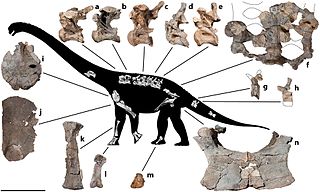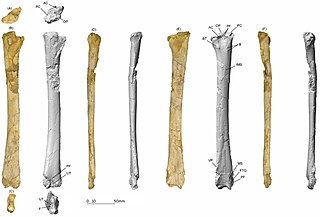
Bengo is a province of Angola. Its capital is Caxito. It has an area of 31,371 square kilometres, and its population as of the 2014 Census was 356,641. The province was created in 1980 by dividing the original province of Luanda into Bengo and a new smaller province of Luanda.

Adamastor is a mythological character created by the Portuguese poet Luís de Camões in his epic poem Os Lusíadas, as a personification of the Cape of Good Hope, symbolizing the dangers of the sea and the formidable forces of nature challenged and ultimately overcome by the Portuguese during the Discovery Age. Adamastor manifests itself out of a storm.

Titanosaurs were a diverse group of sauropod dinosaurs, including genera from all seven continents. The titanosaurs were the last surviving group of long-necked sauropods, with taxa still thriving at the time of the extinction event at the end of the Cretaceous. This group includes some of the largest land animals known to have ever existed, such as Patagotitan—estimated at 37 m (121 ft) long with a weight of 69 tonnes —and the comparably-sized Argentinosaurus and Puertasaurus from the same region.

Argyrosaurus is a genus of titanosaurian sauropod dinosaur that lived about 70 million years ago, during the Late Cretaceous Period of what is now Argentina.
Agustinia is a genus of sauropod dinosaur from the Early Cretaceous Period of South America. It contains the single species Agustinia ligabuei, a single specimen which was recovered from the Lohan Cura Formation of Neuquen Province in Argentina. It lived about 116–108 million years ago, in the Aptian-Albian stage of the Early Cretaceous Period.

Macronaria is a clade of sauropod dinosaurs. Macronarians are named after the large diameter of the nasal opening of their skull, known as the external naris, which exceeded the size of the orbit, the skull opening where the eye is located. Fossil evidence suggests that macronarian dinosaurs lived from the Middle Jurassic (Bathonian) through the Late Cretaceous (Maastrichtian). Macronarians have been found globally, including discoveries in Argentina, the United States, Portugal, China, and Tanzania. Like other sauropods, they are known to have inhabited primarily terrestrial areas, and little evidence exists to suggest that they spent much time in coastal environments. Macronarians are diagnosed through their distinct characters on their skulls, as well as appendicular and vertebral characters. Macronaria is composed of several subclades and families notably including Camarasauridae and Titanosauriformes, among several others. Titanosauriforms are particularly well known for being some of the largest terrestrial animals to ever exist.
Venenosaurus was a sauropod dinosaur. The name literally means "poison lizard", and it was named so after the Poison Strip Member of the Cedar Mountain Formation in Utah, United States, where the fossils were discovered by a Denver Museum of Natural History volunteer Tony DiCroce in 1998. Venenosaurus dicrocei was first described as a new species in 2001 by Virginia Tidwell, Kenneth Carpenter, and Suzanne Meyer. Venenosaurus is a relatively small titanosauriform sauropod, measuring 12 metres (39 ft) long and weighing 6 metric tons. It is known from an incomplete skeleton of an adult and a juvenile. The holotype is DMNH 40932 Denver Museum of Natural History. The specimen consisted of tail vertebrae, the left scapula, right radius, left ulna, metacarpals, forefoot phalanges, right pubis, left and right ischia, metatarsals, chevrons, and ribs.

Octávio Mateus is a Portuguese dinosaur paleontologist and biologist Professor of Paleontology at the Faculdade de Ciências e Tecnologia da Universidade Nova de Lisboa. He graduated in Universidade de Évora and received his PhD at Universidade Nova de Lisboa in 2005. He collaborates with Museu da Lourinhã, known for their dinosaur collection.
Brohisaurus is a genus of titanosauriform sauropod dinosaur from the Late Jurassic, based on largely indeterminate fragments of some ribs, vertebrae, and limb bones. The type and only species, B. kirthari, was described by M. Sadiq Malkani in 2003 and it is currently the only valid genus of dinosaur known from Pakistan to date. The genus name means "Baluchi lizard" and refers to the Baluchi people who live in the area where it was found. The species name refers to the Kirthar Mountains. The fossils were discovered in the lowest portion of the Kimmeridgian Sembar Formation from the Kirthar foldbelt in Pakistan.

Dongyangosaurus is a genus of titanosaurian sauropod dinosaur from the Late Cretaceous. The only species is Dongyangosaurus sinensis, from which only a single fragmentary skeleton is known, coming from the Zhejiang province of eastern China. It was described and named by Lü Junchang and colleagues. Like other sauropods, Dongyangosaurus would have been a large quadrupedal herbivore.
Malarguesaurus is a genus of titanosauriform sauropod dinosaur from the Late Cretaceous of Mendoza Province, Argentina. Its fossils, consisting of tail vertebrae, chevrons, ribs, and limb bones, were found in the upper Turonian-lower Coniacian Portezuelo Formation of the Neuquén Group. The type species, described by González Riga et al. in 2008, is M. florenciae.

Diamantinasaurus is a genus of titanosaurian sauropod from Australia that lived during the early Late Cretaceous, about 94 million years ago. The type species of the genus is D. matildae, first described and named in 2009 by Scott Hocknull and colleagues based on fossil finds in the Winton Formation. Meaning "Diamantina lizard", the name is derived from the location of the nearby Diamantina River and the Greek word sauros, "lizard". The specific epithet is from the Australian song Waltzing Matilda, also the locality of the holotype and paratype. The known skeleton includes most of the forelimb, shoulder girdle, pelvis, hindlimb and ribs of the holotype, and one shoulder bone, a radius and some vertebrae of the paratype.

The geology of Angola includes large areas of Precambrian age rocks. The west of the country is characterized by meta-sedimentary rocks of Proterozoic age including tillites assigned to the Bembe System. Overlying these are a thick pile of limestones and other marine sediments laid down during the Mesozoic and Cenozoic eras. Amidst the Proterozoic sequence are areas of crystalline basement dating from the Archaean. More Archaean basement rocks form the Kasai Craton in northeastern Angola. In the north, within the Cassanje Graben are clastic sediments and volcanic rocks of the Karoo Supergroup. Kimberlites and carbonatites resulting from magmatic activity during the Karoo period are found along a northeast-southwest line through the country. Continental sediments of the Kalahari Group are widespread in eastern Angola.
The Bentiaba is a river in southern Angola. Its mouth is at the Atlantic Ocean near the commune of Bentiaba in Namibe Province.

Cardiocorax is an extinct genus of elasmosaurid known from the Late Cretaceous Mocuio Formation of Namibe Province, southern Angola. It contains a single species, Cardiocorax mukulu.
Lohuecotitan is an extinct genus of titanosaurian sauropod dinosaur which lived during the Late Cretaceous in Spain. The only species known in the genus is Lohuecotitan pandafilandi, described and named in 2016.

Savannasaurus is a genus of titanosaurian sauropod dinosaur from the Late Cretaceous Winton Formation of Queensland, Australia. It contains one species, Savannasaurus elliottorum, named in 2016 by Stephen Poropat and colleagues. The holotype and only known specimen, originally nicknamed "Wade", is the most complete specimen of an Australian sauropod, and is held at the Australian Age of Dinosaurs museum. Dinosaurs known from contemporary rocks include its close relative Diamantinasaurus and the theropod Australovenator; associated teeth suggest that Australovenator may have fed on the holotype specimen.
The Itombe Formation is a geological formation of the Kwanza Basin in Angola dated to the Coniacian stage of the Late Cretaceous. The environment of deposition is shallow marine. Reptile fossils have been recovered from the Tadi beds locality within the formation, including the dinosaur Angolatitan, the mosasaurs Angolasaurus and Mosasaurus iembeensis and the turtle Angolachelys.The Itombe formation was formerly considered Turonian in age, but new data suggests to be Coniacian.

Epapatelo is a genus of pteranodontian pterosaur from the late Cretaceous Mocuio Formation of Namibe Province, Angola. The genus contains a single species, E. otyikokolo, known from partial left limb bones.























